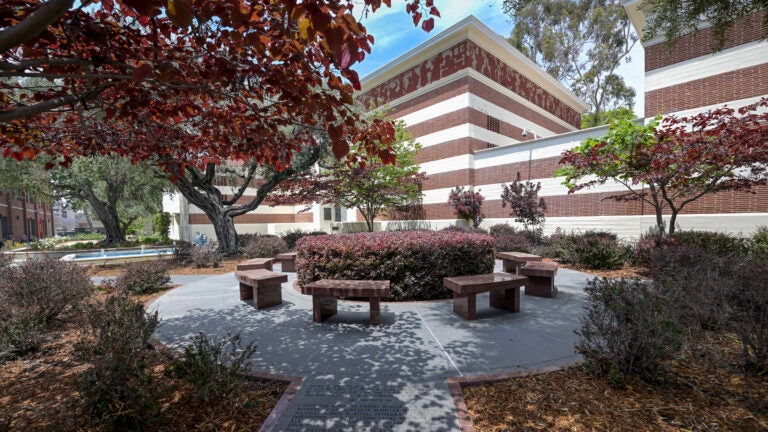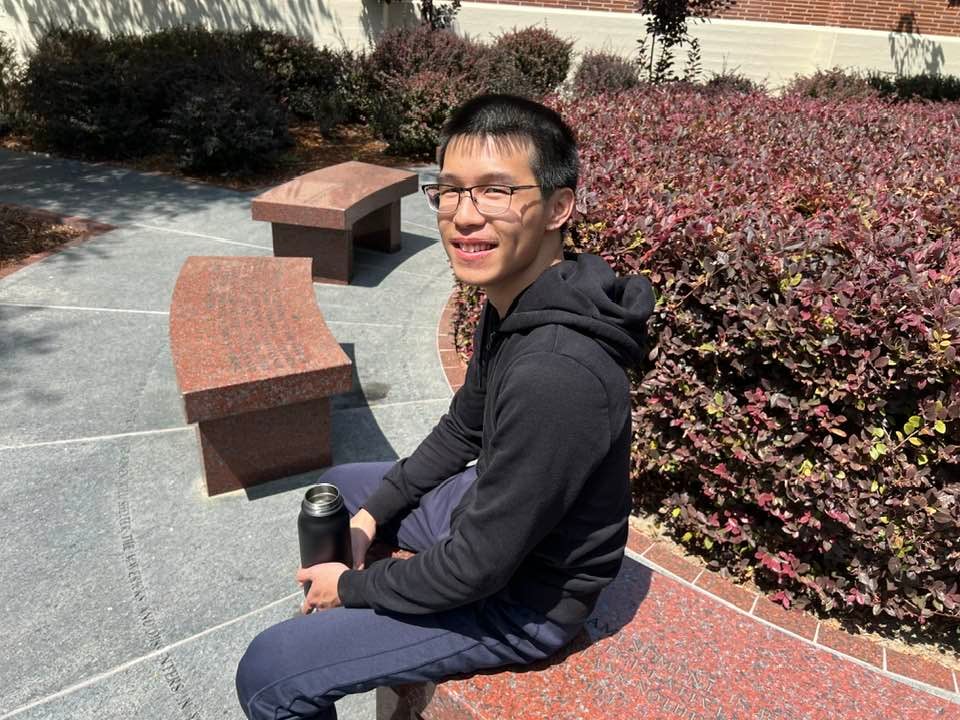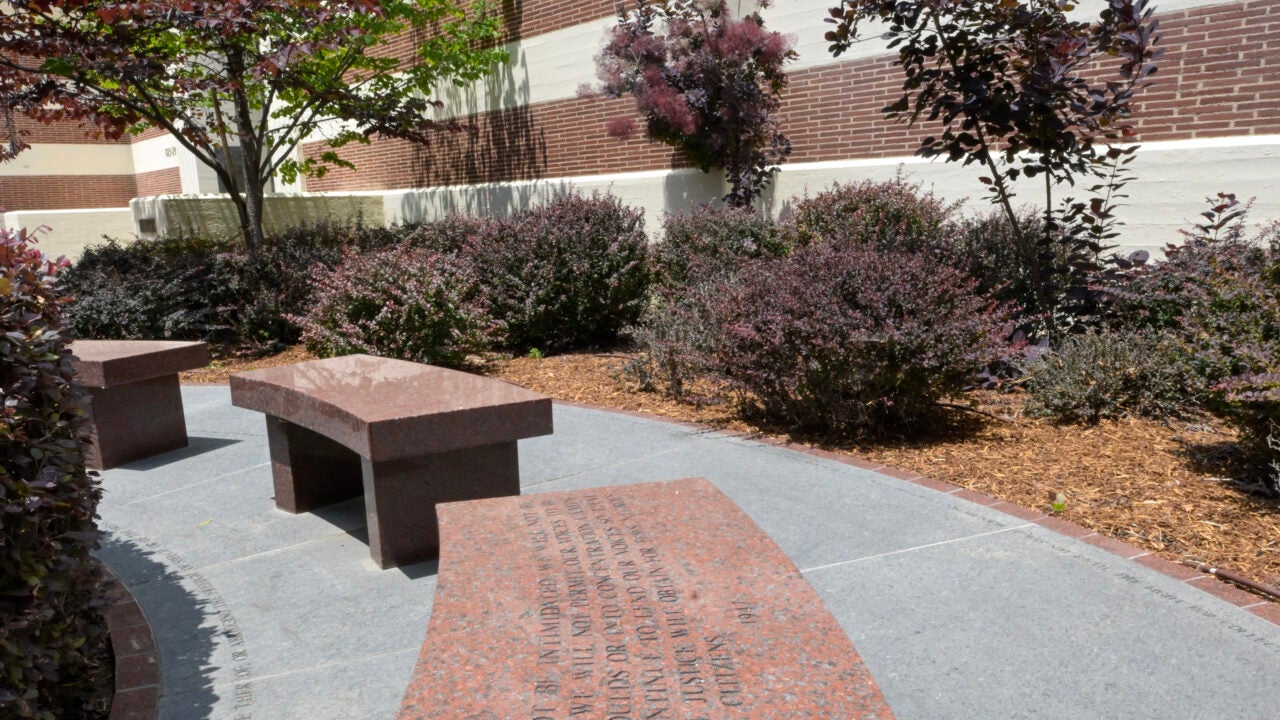Seventy-five years ago this month, the FBI released a report publicly naming well-known film stars as communist activists, leading to a Hollywood blacklist. Jenny Holzer’s installation Blacklist at the Fisher Museum of Art in USC honors the group of producers, directors and screenwriters who refused to answer questions about their political affiliations. (Photo/Gus Ruelas)
University
‘Blacklist’ art installation recalls dark chapter in U.S. history
A hidden gem just outside the USC Fisher Museum of Art centers the “Hollywood Ten” and freedom of speech.
It’s early June and graduate student Jonathan Tam, on an afternoon break, is sitting on a red marble bench outside the USC Fisher Museum of Art. The bench is engraved with a 1947 quote from American novelist, journalist and screenwriter Alvah Bessie: “Either the First Amendment is binding upon Congress and all legislative bodies of our government, or it means nothing at all.”
It is one of 10 benches carved with quotes that are at the heart of Blacklist, an outdoor museum installation by artist Jenny Holzer. It preserves the memory and the words of the Hollywood Ten — a group of producers, directors and screenwriters, including Bessie, who refused to answer questions about possible communist affiliations when called to appear before the House Un-American Activities Committee in the 1940s. They insisted on exercising their First Amendment rights and as a result, spent time in prison for contempt of Congress and were blacklisted for years by Hollywood studios.

“I just stumbled upon this, but I’ve read all of the messages that were engraved on the benches and the steps,” says Tam, a USC Viterbi School of Engineering student earning a master’s degree in cyber security engineering. “It paints a picture of the fear at the time. You can see all these voices that were silenced right here in the U.S., and mainly in Hollywood.”
We live in turbulent times right now. If you are fearful or concerned or think that history doesn’t repeat itself, this is the exact thing that you need to go see.
— Stephanie Kowalick, Fisher Museum of Art
An FBI report heightens fears
The U.S. government’s campaign targeting people in the film industry and accusing them of being communist activists further escalated 75 years ago this week. It was on June 8, 1949, that the FBI released a report publicly naming such well-known film stars as Fredric March, John Garfield, Paul Muni and Edward G. Robinson as communist activists.
“It led to people losing their careers,” says Steven J. Ross, a Distinguished Professor of History at the USC Dornsife College of Letters, Arts and Sciences. “You had someone like Edward G. Robinson, who was never a communist. But he was an ardent anti-fascist, one of the things that got you blacklisted or greylisted. A whole bunch of people who never joined the Communist Party were active in anti-fascist events in which communists participated.”
People who were greylisted, as Robinson was, were no longer hired by Hollywood’s major studios but could find work at minor studios. Ross says a chill was felt throughout Hollywood due to the lists in the 1940s and ’50s, with even the biggest stars realizing they could lose their careers and be unable to support their families.
“If people are faced with losing their livelihoods because they speak out, a lot of people are just going to keep quiet,” says Ross, an author whose books include 2011’s Hollywood Left and Right: How Movie Stars Shaped American Politics. “People really shut their mouths from 1947 until the election of John F. Kennedy in 1960. Only after his election did Hollywood stars who were center-left start talking politically again.”
Remembering those silenced

In the late 1990s, faculty members of the film writing program at the USC School of Cinematic Arts formed the First Amendment/Blacklist Project committee to address the fact that many future filmmakers knew very little about this dark period in U.S. history that destroyed the careers of so many creative people.
The committee unanimously chose well-known contemporary artist Holzer — known for her presentation of words and ideas in public spaces — to create a work of art in a public setting focused on the government’s blacklisting campaign. The result in 1999 was a secluded garden in front of the Fisher Museum of Art, located in a quiet section of USC’s University Park Campus along Exposition Boulevard.
“[Holzer] made her name with these very bold, visible quotes that are meant to get you to think,“ says Stephanie Kowalick, Fisher Museum of Art’s director of collections, compliance and exhibitions. “Just from an aesthetic perspective, I think she’s done a beautiful job of highlighting the different viewpoints and how important free speech is, period. It also just really honors the people who lost their livelihood to the blacklist.”
Including Bessie, the individuals who made up the Hollywood Ten and are represented in the Blacklist garden are Herbert Biberman, Lester Cole, Edward Dmytryk, Ring Lardner Jr., John Howard Lawson, Albert Maltz, Samuel Ornitz, Adrian Scott and Dalton Trumbo. In addition to the names and quotes on the granite benches, five paths lead to the installation’s central garden made up of red and gray slabs, with quotes from others offering alternative perspectives on freedom of speech and ideas.
Supreme Court Justice William O. Douglas summed up the atmosphere of the blacklist era and its impact on freedom of speech in his engraved 1952 quote: “Fear has mounted — fear of losing one’s job. Fear of being investigated. Fear of being pilloried. This fear has stereotyped our thinking, narrowed the range of free public discussion and driven many thoughtful people to despair.”
Still a timely message
Kowalick hopes that the 75th anniversary of the FBI list’s publication will serve as motivation for people to visit the Blacklist garden, which is open to everyone, anytime, and is part of the museum’s permanent collection.
“We live in turbulent times right now,” she says. “If you are fearful or concerned or think that history doesn’t repeat itself, this is the exact thing that you need to go see and familiarize yourself with. History is cyclical, and we should be learning from it all the time.”
Although the garden is located in a part of campus that is not well-trafficked, it is a quiet, open space for reflection. That’s why Tam, who works as a webmaster at the USC School of Architecture, often finds himself returning to the spot for his afternoon breaks.
“Someone can eat their lunch here and not even really know what’s there,” says Tam, who served six years in the U.S. Navy before returning to school. “This is a pretty quiet but also powerful place.”



